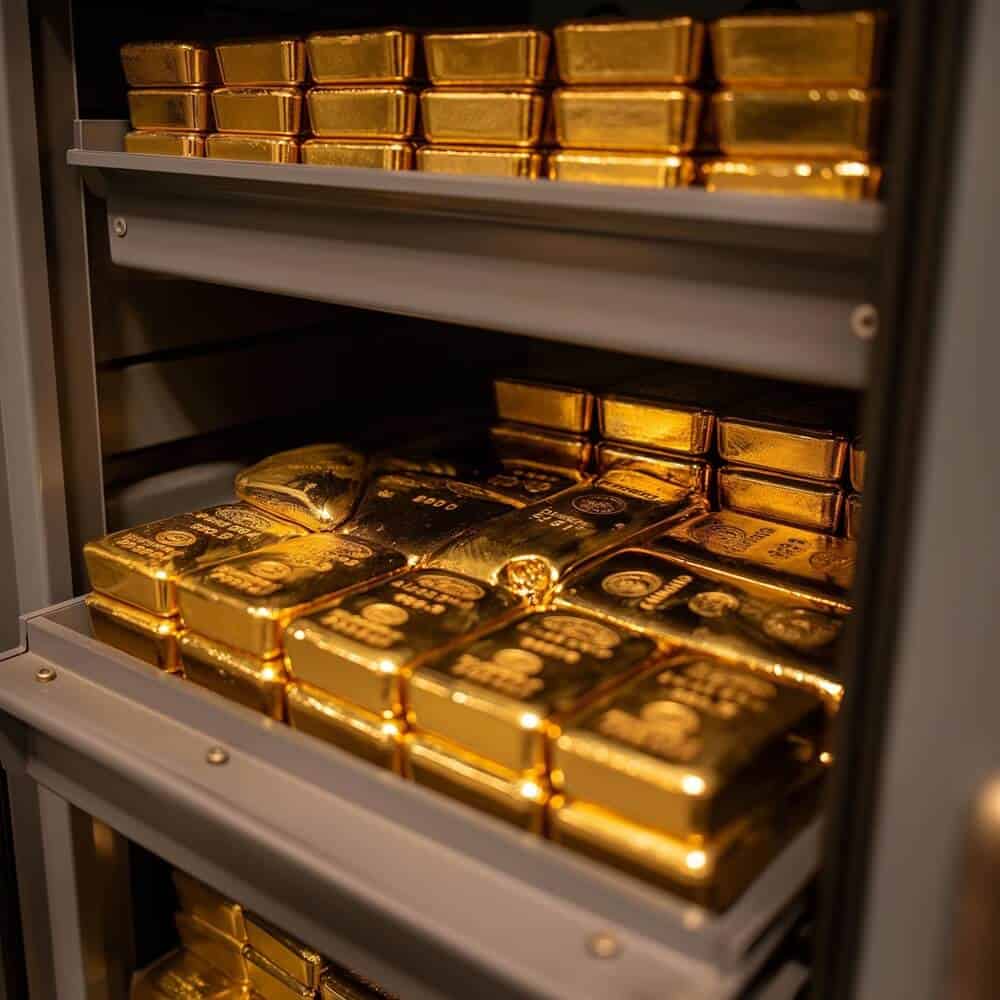- Our content is independently written and reviewed by trusted reviewers & fact-checkers.
- Your information is never sold. We can earn money by connecting you with top Gold IRA Companies. Learn how our reviews work.
- Want to learn more? Meet our authors and explore our editorial policy.

Gold bars have long been valued as an alternative investment and store of wealth. From massive 400-ounce behemoths to tiny 1-gram bars, gold in bar form offers investors exposure to the yellow metal in sizes to suit any budget. But how much is a bar of gold worth? Read on to find out.
Table of Contents
Key Takeaways
- The value of a gold bar depends heavily on the purity of gold in the bar, measured in karats or fineness. Higher purity means higher value.
- The gold spot price fluctuates daily and serves as the base price per troy ounce.
- Standard gold bars are made in set weights, so you’ll need to calculate based on the spot price.
- Dealers charge a premium over the spot price that covers manufacturing, shipping, and their profit margin.
- Well known mints and manufacturers may command higher premiums for their products.
Understanding Gold Bar Weight and Purity
The weight of a gold bar is measured in troy ounces rather than standard ounces. The troy ounce is used specifically for precious metals and is equal to 1.097 standard ounces. This distinction is important when calculating the value of a gold bar.
Gold bars come in a variety of sizes, with some of the most commonly recognized standards including:
- 1 Gram: Often considered an entry point for gold investors, these tiny bars are more affordable but come with higher premiums over the spot price of gold due to their small size.
- 5 Grams: A small but more substantial option for investors starting out or looking to gift gold.
- 10 Grams: Provides a balance between affordability and a significant quantity of gold.
- 1 Ounce (approximately 31.1 Grams): One of the most popular sizes for investors globally. Gold bars and coins are often found in this size.
- 50 Grams: Offers a significant investment in gold without moving to the larger bar sizes.
- 100 Grams: A mid-sized bar that balances investment heft with manageable pricing.
- 10 Ounces (Approximately 311 Grams): Preferred by serious investors looking to add a substantial amount of gold to their holdings.
- 1 Kilogram (1,000 Grams or Approximately 32.15 Ounces): Popular among institutional investors and high-net-worth individuals, offering a lower premium over spot in comparison to smaller bars.
- 400 Ounces (Approximately 12.4 Kilograms): The 400 ounce bar, also known as a ‘Good Delivery Bar’, is the large standard bar that is traded between governments, central banks, and major financial institutions.
Gold Purity
The purity of gold bars refers to the amount of actual gold content relative to other metals. Gold purity is measured in karats or fineness.
Fineness refers to the percentage of pure gold in the bar. 24K gold, for example, has a fineness of 999.9 which means it is 99.99% pure gold. Lower fineness numbers indicate less pure gold. Common fineness levels for gold bars include 999.9, 999, 995, 986, 916, 835, and so on.
The karat system is commonly used in the jewelry industry to indicate gold purity. Pure 24k gold is equivalent to 99.9% purity or 999.9 fineness. Lower karat numbers contain less gold, such as 22k (91.67% gold), 18k (75% gold), 14k (58.33% gold), and 10k (41.67% gold).
In general, gold bars with higher purity and fineness carry higher premiums over the base gold spot price. 99.99% pure gold bars command the highest premiums, while bars with fineness between 91.7% to 99.95% have lower premiums.
Low purity gold bars under 40% are considered scrap gold and have only small premiums over the melt value.
The purity level stamped on a gold bar is one of the main factors dealers use to determine the bar’s value and premium over spot gold prices.
Gold Spot Price and Its Impact
The gold spot price is the current market price per ounce of gold. This price fluctuates constantly based on supply and demand and other global market forces. The spot price is often used as a benchmark to determine the value of gold products.
Gold trades actively on global markets and exchanges. As a result, the spot price can change every few seconds throughout the day. You can easily track the live gold spot price using sites like Kitco and APMEX.
How to Calculate Gold Bar Value

To calculate the value of a specific gold bar, you simply need to know its weight and purity, along with the current spot price of gold. The formula to use is:
Value of Gold Bar = Weight in Troy Ounces x Purity (as a decimal) x Price of Gold per Troy Ounce
For example, let’s say you have a 1 ounce gold bar that is .999 fine. One troy ounce is equal to 31.1 grams. Assuming that the gold spot price is $1,800 per troy ounce, here is the math:
- Bar weight: 1 troy oz = 31.1 grams
- Purity: .999 fine gold
- Gold spot price: $1,800 per troy ounce
Calculation: 1 troy oz x 0.999 x $1,800 per oz = $1,803.17
So the total value of this 1 ounce .999 fine gold bar would be $1 803.17 at a spot price of $1,800 per ounce.
You can use this same calculation for bars of any size – just adjust the weight accordingly. This method works for valuing bars from 1 gram up to the typical 400 oz. monetary bars.
Remember, knowing the current gold spot price is key to determining the real-time value.
Dealer Premiums
Gold bars do not simply sell for the current spot price, as dealers charge what is known as a “premium” above the spot price. This premium reflects the dealer’s profit margin as well as costs associated with producing, storing, and shipping the gold bars.
Premiums on gold bars vary based on several factors:
- Manufacturer Reputation – Bars from well-known mints like PAMP Suisse demand higher premiums than off-brand manufacturers. Valcambi and Argor-Heraeus bars also command premium pricing.
- Minting Costs – The mint that produces the gold bars incurs costs for manufacturing, packaging, security, and certification. Popular government mints like the Royal Canadian Mint or US Mint charge more as their gold bars are highly trusted. Private mints may have lower premiums.
- Certification: Certified and serialized gold bars with assurances of weight and purity by trusted mints command higher premiums than generic “cast bars.
- Bar Size – The cost of manufacturing 1 gram bars is higher per ounce than larger, 1 kilo bars. Thus, premiums are inversely related to bar size. Smaller bars command higher percentage premiums.
- Gold Purity – .9999 fine “four nines” gold bars receive a slightly higher premium over .999 “three nines” bars.
- Specialty Bars – Unique or limited mintage bars often trade at considerable premiums to generic, mass produced bars due to collectability.
- Supply and Demand – Shortages and increased demand for physical gold may drive premiums higher, especially during market volatility or economic crises.
When buying gold bars, know that you will pay 3-8% above the spot price depending on these factors. Research reputable dealers and compare premiums to find the best deals.
Gold Bars vs. Gold Coins

Gold bars and gold coins are both popular investment options, but they have some key differences that are worth considering.
Liquidity
Gold coins tend to be much more liquid than large gold bars. Coins like the American Gold Eagle come in smaller denominations (1 oz, 1/2 oz, 1/4 oz) that are easier to sell at local coin shops or online. Large 400 oz gold bars can be more difficult to find buyers for.
Premiums
The manufacturing and distribution process for coins means they sell for higher premiums over the spot price. Gold bars have lower premiums in general, making them more cost-efficient on a per-ounce basis. However, some collectible coins command substantial premiums.
Storage
Storing gold coins is easier than storing large gold bars since they take up less space. This makes coins easier to store at home in a safe or safety deposit box. Large gold bars often require professional storage arrangements.
Divisibility
Gold coins can be sold in fractions of an ounce if needed. It’s not as easy to divide up gold bars into smaller units. This provides more flexibility.
Tips for Investing in Gold Bars
- Know Your Investment Goals: Decide if your goal is long-term wealth preservation, hedging against inflation, or speculative gains. Your objective will influence the size and type of gold bars you should consider.
- Research Before Buying: Understand the current gold market, including spot prices and forecasts. Knowledge is power, especially in commodities investing.
- Choose Reputable Dealers: Only buy gold bars from well-known, reputable dealers. This ensures authenticity and fair pricing. Consider dealers with professional accreditation, like from the LBMA (London Bullion Market Association).
- Consider Storage Solutions: Decide in advance where you will store your gold bars. Whether it’s a home safe or a bank deposit box, ensuring the security of your investment is crucial.
- Understand the Premiums: Be aware that purchasing gold bars will entail paying a premium over the spot price. Compare premiums among different sizes and dealers to find the best deal for your investment.
- Diversify Within Gold Investments: Don’t put all your money in one type or size of gold bar. Consider diversifying with gold coins or other precious metals for a more balanced investment portfolio.
- Keep Track of Your Investment: Regularly check the market value of your gold against its purchase price and the current gold price. This will help you make informed decisions about buying more or selling.
- Stay Informed: Keep up with financial news, particularly regarding monetary policies and economic conditions that could affect gold prices.
- Long-term Perspective: Gold is traditionally a long-term investment. Be prepared for price fluctuations and avoid panic selling during downturns.
- Plan for Taxes and Fees: Understand the implications of taxes and potential fees when buying or selling gold bars. This can affect the overall profitability of your investment.
Final Thoughts
When it comes to buying gold bars, it’s essential to have a solid grasp of the factors that determine their value. The price per ounce is primarily driven by the prevailing gold spot price. However, the total price you pay will also be affected by the bar’s weight, gold purity, and any premiums charged by the dealer.
The gold spot price fluctuates daily based on global supply and demand. But regardless of market swings, gold bars remain an attractive investment option for many. Their enduring value makes them a wise addition to a diversified portfolio.
Article Sources
At Gold IRA Blueprint, we dive deep into the world of gold IRAs, using trusted sources to back up our insights. Our sources range from official documents to expert interviews, ensuring our content is both accurate and reliable. We also draw on research from reputable publishers to give you the most comprehensive understanding possible. Check out our editorial policy to see how we maintain our high standards for accuracy and fairness. Also make sure to check out our Financial Review Process to have a better understanding of our process.
- Benzinga. (n.d.). How Much is a Gold Bar Worth? Retrieved from https://www.benzinga.com/money/how-much-is-a-gold-bar-worth/
- Gold Core. (n.d.). What are Gold Bars? Retrieved from https://www.goldcore.com/info/what-are-gold-bars/
- Guardian Gold. (n.d.). Gold Purity 101: Your Ultimate Guide to Understanding Gold’s Quality. Retrieved from https://guardiangold.ca/blog/gold-purity-101-everything-you-need-to-know/
- StoneX Bullion. (2024). Gold Purity, Fineness, And Karat – What Is It And How To Check It. Retrieved from https://stonexbullion.com/en/blog/understanding-gold-purity/
- Phi Wallet. (2023). Understanding Gold Spot Price: What You Need to Know. Retrieved from https://www.linkedin.com/pulse/understanding-gold-spot-price-what-you-need-know-phiwallet/
- LendEDU. (2024). How Much Is a Gold Bar Worth? Retrieved from https://lendedu.com/blog/how-much-is-gold-bar-worth/
- Schiff Gold. (2023). Understanding Premiums. Retrieved from https://schiffgold.com/key-gold-news/understanding-premiums/
- Gerrards. (n.d.). Gold Bars vs Gold Coins: What is better to buy?
- https://gerrardsbullion.com/investment-guide/gold-bars-vs-gold-coins/














